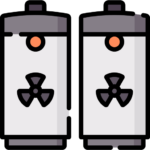Oil and gas waste management
Compare deals with our business waste experts
Just enter your business postcode…
Compare deals with our business waste experts
Just enter your business postcode…
The UK’s offshore oil and gas sector generates vast amounts of waste, including ‘produced’ wastewater from extraction, drill cuttings, drilling fluids, spent chemicals, and materials from decommissioning pipelines and ageing wells, such as tank sludge, radioactive scale, and metal scrap.
Onshore, industries like hospitality, and events also contribute to the sector’s waste footprint by using oil and gas in day-to-day operations.
Below, we explore the key aspects of oil and gas waste, including oil and gas waste types, industry regulations, waste management technology, environmental impacts and commercial waste disposal solutions.
The oil and gas sector generates a wide range of waste, from production byproducts to decommissioned materials. Each type requires careful handling to ensure environmental compliance and safe disposal. Here are the key waste streams and how they are managed:

Estimated Volume: Hundreds of millions of tonnes per year
A byproduct of extraction containing salts, hydrocarbons, and chemicals. Most is treated and re-injected into wells, with excess discharged at sea or sent onshore for further treatment.

Estimated Volume: 1-2 million tonnes per year
Rock and soil fragments from drilling. Treated and disposed of at sea or recycled onshore for construction or landfill cover.

Estimated Volume: 80,000 tonnes per year
Includes chemicals, oils, and tank sludge from drilling and refining. Transported onshore for special treatment, recycling, or disposal.

Estimated Volume: 22,000 tonnes per year
From decommissioned equipment and infrastructure. Recycled, salvaged, or disposed of if contaminated.

Estimated Volume: 10,000 tonnes per year
Includes drums, containers, and mixed industrial waste. Managed through various recycling and disposal methods.

Estimated Volume: 1,000 tonnes per year
Naturally occurring radioactive deposits in pipes and equipment. Processed onshore under radioactive waste regulations.
The oil and gas industry generates millions of tonnes of waste each year, with much of it managed offshore. While advancements in regulations and treatment methods have improved environmental outcomes, waste handling remains a critical challenge.

Over 95% of oil and gas waste comes from produced water and drill cuttings, byproducts of drilling and extraction processes. These materials require careful management to prevent environmental harm.

Around 70-80% of ‘produced’ water is reinjected into wells to maintain pressure for oil recovery. The remaining portion is treated for reuse, recycling, or disposal.

Some drill cuttings, drilling fluids, and treated produced water are disposed of offshore. While past practices caused significant environmental damage, stricter regulations have reduced impacts.

Around 120,000 tonnes of waste, including spent chemicals, oils, scrap metals, tank sludge, and radioactive scale, is transported onshore for specialised treatment, recycling, or disposal.

As the UK moves away from fossil fuels, the total volume of oil and gas waste decreases year-on-year, reflecting reduced extraction activity.

A small but significant portion (~1%) of oil and gas waste contains hazardous chemicals and radioactive materials, requiring stringent handling and disposal under special regulations.
We provide waste collection services to support the oil and gas industry, offering reliable commercial waste solutions throughout the UK.

Aberdeen is a big part of the offshore energy sector, with a busy network of ports, warehouses, and crew accommodation. Our commercial waste collection in Aberdeen supports these sites by efficiently managing commercial cardboard recycling, packaging, and food waste. We provide reliable and compliant waste management for hotels, staff canteens, and logistics companies across Dyce, Altens, and Aberdeen Harbour.

Southampton plays a key role in the oil industry, hosting Esso’s Fawley Refinery and surrounding marine terminals. We support local businesses from haulage yards and port offices to cafes, with tailored commercial waste services. Our Southampton business waste collection covers general waste, mixed recycling, food bins, and commercial glass recycling collection.

Plymouth’s dockyards generate a steady flow of commercial waste from offices, workshops and port cafes. We provide reliable waste collection services across Devonport and nearby areas, including options for food waste, commercial mixed recycling, general waste, and glass. Whether you’re a small marine supplier or a large contractor, we help keep your site clean and compliant. Explore our waste collection services for businesses in Plymouth.

From ferry terminals to supply chain warehouses, Portsmouth supports a wide range of industries linked to the oil and maritime sectors. Our Portsmouth commercial waste collection helps local businesses manage their waste sustainably, including regular collections for general waste, cardboard, plastic, and waste from the hospitality industry. We also work with hotels, retail units, and staff facilities near Portsmouth International Port.

Hull’s industrial docks and logistics hubs support everything from chemical processing to freight handling. The wider area also includes cafes, office units, engineering workshops, and port-based hospitality venues, all of which produce regular commercial waste. Our Hull business waste collection service helps local companies manage general waste, recycling, packaging materials, and food waste.

Liverpool’s Merseyside port and energy infrastructure bring together a mix of commercial operations, including fuel logistics, local warehouses, offices, and accommodation providers. Our Liverpool commercial waste collection includes bins for general waste, cardboard, glass, and food waste. Whether you operate a freight hub or hotel near the docks, we help you stay compliant and meet sustainability goals.
Unlike standard commercial properties, commercial waste disposal in the oil and gas sector is highly complex. Offshore platforms, drilling sites, refineries, and pipelines generate diverse and often hazardous waste streams, requiring specialist handling and disposal.
To ensure compliance, efficiency, and environmental responsibility, the industry relies on specialist commercial waste disposal services, including:
Despite its environmental challenges, the oil and gas sector has implemented business waste minimisation strategies, to improve efficiency and cut commercial waste disposal costs.
While the sector is often scrutinised for the environmental impact of its commercial waste, these cost-driven waste reduction efforts have also contributed to building UK recycling infrastructure and advancing circular economy mechanisms.
Standard UK commercial waste regulations apply to oil and gas waste once it reaches onshore, past the low tide mark. However, offshore waste, where the majority of oil and gas waste is generated, falls under a different set of specialist regulations due to its hazardous nature.

These are the key specific regulations governing oil and gas waste:

The following agencies enforce oil and gas waste regulations:
The oil and gas industry has long invested in cutting-edge technologies to improve efficiency and profitability. With increasing environmental pressures, companies are now using this financial power to develop advanced waste management technologies that handle, treat, and dispose of difficult-to-recycle waste.



Oil and gas waste can cause serious environmental damage if not properly managed. While regulations have improved waste handling, contamination, pollution, and radiological risks remain.
Below, we look at oil and gas waste’s key impacts on the environment:

Improper drilling mud and cuttings disposal can pollute offshore seabeds and onshore soil. This contamination affects ecosystems, disrupts marine life, and may lead to groundwater pollution.

‘Produced water’, containing hydrocarbons, salts, and chemicals, can contaminate seawater and freshwater sources. Leaks from pipelines, tanks, and equipment further increase the risk of pollution.

Naturally Occurring Radioactive Material (NORM) in oil and gas waste poses health and environmental hazards. Strict handling, treatment, and disposal methods are required to prevent exposure.

Decades of oil and gas extraction have left drill-cutting piles up to 60 metres high on the seabed. Some contaminants have been found 4km from offshore platforms, highlighting long-term pollution risks.

Before strict regulations, spent drilling fluids were dumped into landfills and oceans without treatment, leading to severe pollution. The EU Waste Framework Directive (2008) introduced mandatory treatment before disposal.